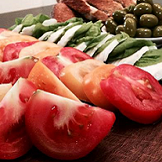 We’ve mentioned that veganism and gluten-free diets are trending, and not too long ago, Maeve Webster of Datassential hosted shared a compelling webinar about foodservice trends and how they’re shaping the produce industry. Pickled foods, small plates, burgers and upscale Southern cuisine were all mentioned as trending ways to introduce new flavors and fresh ingredients to the mainstream palette. For instance, your pickiest friend may be hesitant to try roasted artichokes, but stick the artichokes on a burger or give them a good ol’ Southern fry, and it’s a whole new story.
We’ve mentioned that veganism and gluten-free diets are trending, and not too long ago, Maeve Webster of Datassential hosted shared a compelling webinar about foodservice trends and how they’re shaping the produce industry. Pickled foods, small plates, burgers and upscale Southern cuisine were all mentioned as trending ways to introduce new flavors and fresh ingredients to the mainstream palette. For instance, your pickiest friend may be hesitant to try roasted artichokes, but stick the artichokes on a burger or give them a good ol’ Southern fry, and it’s a whole new story.
Webster’s emphasis on fresh produce was reiterated in the Predicting Global Food Trends session at last month’s PMA Foodservice Conference, where she and other credited foodies like celebrity chef Jet Tila and CIA Director of Corporate Relations, Susan Renke, shared their insights regarding how global food is increasing the amount of fresh produce consumers are eating (and trying). Some of the highlights from the session include:
- Fresh produce is key when it comes to seasoning food—especially for those looking to limit their sodium intake. Flavorful ingredients like herbs, spices, peppers and onions add tons of flavor without any additional salt!
- 90% of operators and consumers believe produce can make a dish more authentic.

The pickled veggies in Bahn Mi sandwiches are quintessential Vietnamese, an olive and cheese platter screams Mediterranean, and nothing says Southern like fried green tomatoes. - Nordic cuisine is headed our way, people.
- Consumers are becoming increasingly more interested in local and seasonal produce, which in turn is opening their palette to new foods.
- Ethnic food represents familiar food in a different way, or as chef Tila called it, “familiar with a twist.” For example, “bibimbap” is a signature Korean dish you may not recognize. However when you explain that it’s really just a rice bowl with meat and veggies…it doesn’t sound so daunting anymore!
- Speaking of Korean food, Asian food as a whole is one of the most widely accepted (and loved) cuisines in the US. So much so, that its influence has even blurred into non-Asian menus. Think Subway’s new Sriracha sauce or the inevitable teriyaki flavor at almost any wing place. (The same holds true for Mexican cuisine. Chipotle flavors…everywhere!)
- The Menu adoption cycle is as follows: inception, adoption, proliferation, and ubiquity. Thanks to all of these trends, produce is definitely becoming a ubiquitous ingredient!
The point is, these trends represent a huge opportunity for fresh food brands to show off their products. Unlike junk food brands who need to clarify their products are gluten-free, dairy-free, “fresh,” etc. (or modify their recipes), produce is a special type of food that naturally meets all of these requirements. Keeping tabs on upcoming food trends is a source of valuable content for you to share on social media, blog posts, recipe development, and anything else to help you to attract, connect with, convert and delight consumers. Food trends are just another way the produce industry will not only keep, but sit at the head, of the food marketing table!
{{cta(‘3de60b2b-1bb3-4585-b10b-c5a1f259a5f1’)}}











